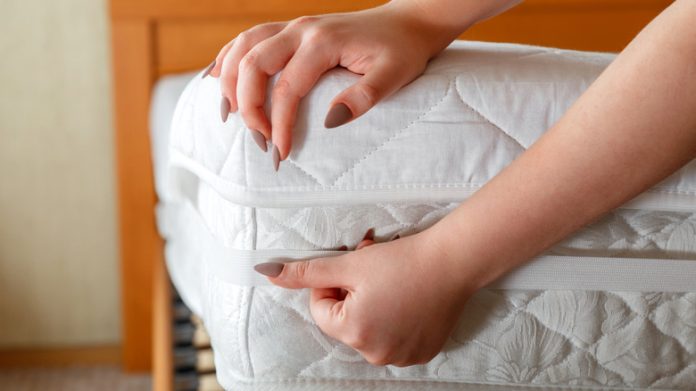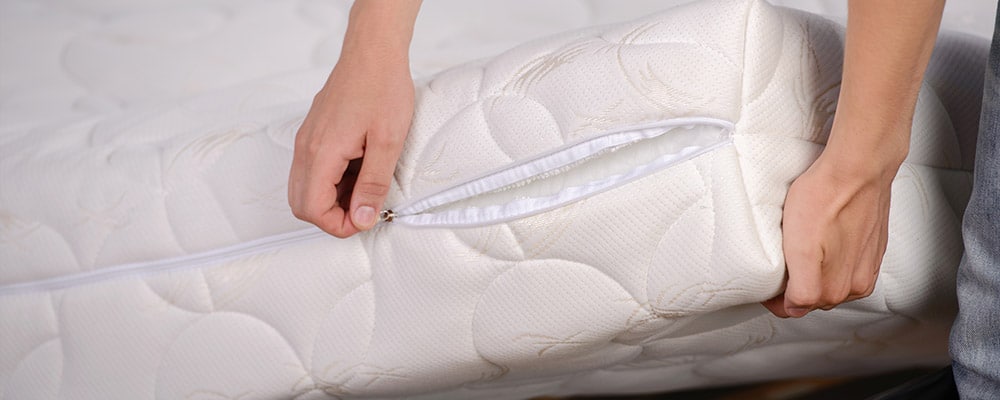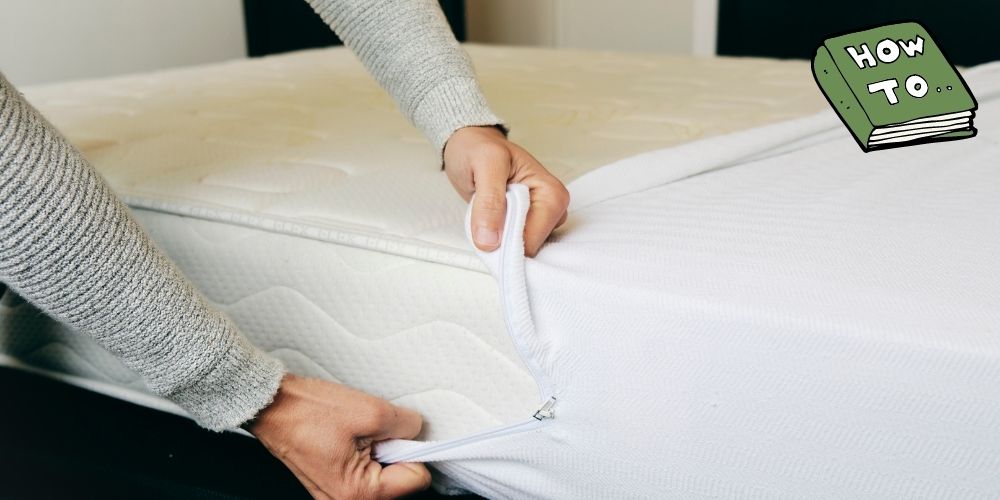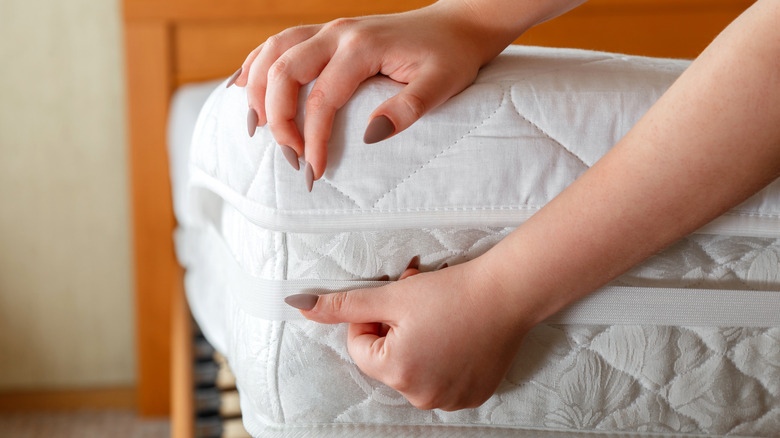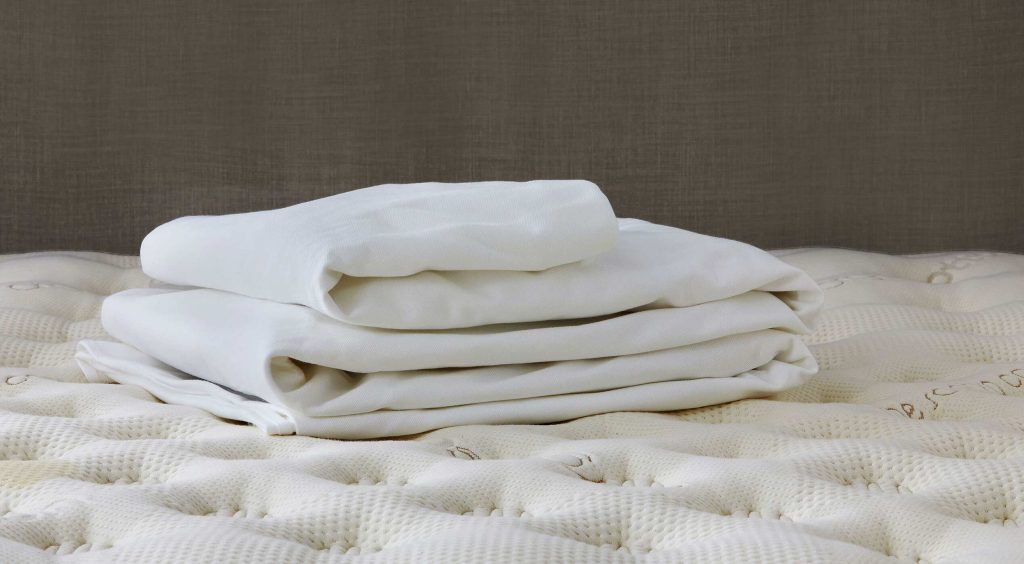Have you ever wondered if you can wash your mattress protector? Well, we have some good news for you! In this article, we will provide you with all the information you need to know about washing your mattress protector. So, say goodbye to doubts and worries, and let’s dive into the world of mattress hygiene!
Review contents
Can Mattress Protector Be Washed?
As responsible owners of a mattress protector, it’s important for us to maintain its cleanliness and overall hygiene. After all, a mattress protector is designed to safeguard our mattresses from spills, stains, and allergens. Over time, these protectors can accumulate dirt, dust, and sweat, which can affect their effectiveness. So, can mattress protectors be washed? The answer is a resounding yes! In this article, we will explore the importance of washing mattress protectors, the different types available, cleaning instructions found on the label, machine washing techniques, hand washing methods, drying techniques, frequency of washing, stain removal tips, precautions to take while washing, and even alternatives to washing.
Importance of Washing Mattress Protectors
Maintaining Hygiene:
One of the primary reasons to wash mattress protectors is to ensure hygiene. Mattress protectors shield our mattresses from spills, pet dander, sweat, and other bodily fluids. Washing them regularly prevents the buildup of these substances, which can lead to the growth of bacteria and other microbes. By keeping our mattress protectors clean, we create a healthier sleeping environment for ourselves and our loved ones.
Prolonging Mattress Protector Lifespan:
Washing mattress protectors not only helps maintain cleanliness but also prolongs their lifespan. Regular washing removes any dirt or debris that may have accumulated on the surface, preventing the material from breaking down prematurely. By caring for our mattress protectors through proper washing, we can ensure they continue to protect our mattresses effectively for an extended period.
Preventing Allergens and Dust Mites:
For individuals who suffer from allergies or asthma, washing mattress protectors is crucial. Over time, dust, allergens, and dust mites can accumulate on the protector’s surface, exacerbating these conditions. By washing the protector regularly, we can effectively remove these irritants and create a cleaner and healthier sleep environment.
Enhancing Sleep Quality:
A clean mattress protector can contribute to a better night’s sleep. When our mattress protectors are fresh and free from stains or odors, we can sleep more soundly, knowing that we are resting on a clean surface. Additionally, washing mattress protectors can help eliminate any unpleasant smells that may have developed over time, improving overall sleep quality.
This image is property of beloitmattress.com.
Types of Mattress Protectors
Cotton Mattress Protectors:
Cotton mattress protectors are a popular choice due to their softness and breathability. They are hypoallergenic and provide a comfortable sleeping experience. These protectors are machine-washable and can withstand frequent washing without losing their shape or functionality.
Polyester Mattress Protectors:
Polyester mattress protectors offer excellent durability and stain resistance. They are often waterproof and provide an additional layer of protection against spills and accidents. Most polyester mattress protectors are machine washable, making them easy to clean and maintain.
Vinyl or Plastic Mattress Protectors:
Vinyl or plastic mattress protectors are designed to be waterproof and offer superior protection against liquid spills and stains. Although they are not as breathable as cotton or polyester protectors, they are extremely easy to clean. These protectors can be wiped down with a damp cloth or sponge, providing a quick solution for accidental spills.
Hypoallergenic Mattress Protectors:
Hypoallergenic mattress protectors are specifically designed for individuals with allergies or sensitivities. They are made from materials that repel allergens, dust mites, and other irritants. Many hypoallergenic protectors are machine washable, allowing for easy maintenance and allergen removal.
Waterproof Mattress Protectors:
Waterproof mattress protectors are an excellent choice for individuals with young children or pets. They offer a protective barrier against liquids, preventing them from seeping into the mattress. While some waterproof protectors are machine washable, it’s essential to check the label for specific cleaning instructions to maintain their waterproofing properties.
Cleaning Instructions on the Label
When it comes to cleaning mattress protectors, it’s always best to refer to the manufacturer’s recommendations. The label attached to the protector usually provides specific instructions on how to clean and care for the product. These instructions may include temperature requirements, the use of specific detergents, and special care instructions.
Following the cleaning instructions on the label ensures that we clean the mattress protector effectively without causing any damage to the materials. It’s essential to read and understand these instructions before proceeding with the washing process.
This image is property of theroundup.org.
Machine Washing
Checking Suitability for Machine Washing:
Before tossing our mattress protector into the washing machine, we need to ensure that it is suitable for machine washing. Most mattress protectors, especially those made of cotton or polyester, can be safely washed in a machine. However, it’s crucial to double-check the label to confirm.
Using Appropriate Wash Cycle:
When machine washing a mattress protector, it’s important to select the appropriate wash cycle. For most protectors, a gentle or delicate cycle is ideal to prevent any damage to the materials. Avoid using harsh washing cycles, such as heavy-duty or high spin cycles, as they may cause the protector to tear or lose its shape.
Choosing the Right Water Temperature:
The label on the mattress protector will indicate the recommended water temperature for washing. Generally, using warm or cold water is suitable for most mattress protectors. Hot water should be avoided unless explicitly specified on the label, as it may cause shrinking or damage to certain fabrics.
Adding Gentle Detergent:
Using a gentle detergent specifically designed for delicate fabrics is recommended when washing mattress protectors. Harsh detergents can deteriorate the materials or cause colors to fade. It’s best to follow the instructions on the detergent label for the appropriate amount to use based on the load size.
Avoiding Harsh Chemicals:
To maintain the longevity and functionality of our mattress protector, it’s important to avoid using harsh chemicals such as bleach or fabric softeners. These chemicals can break down the protector’s materials, reduce its effectiveness, and potentially cause skin irritations or allergies.
Avoiding Overloading the Machine:
When washing a mattress protector, it’s crucial not to overload the washing machine. Overloading can prevent the protector from getting thoroughly cleaned and may even cause damage to the machine. Follow the machine’s capacity guidelines and leave enough space for the protector to move freely in the drum.
Hand Washing
Assessing Suitability for Hand Washing:
If our mattress protector is not suitable for machine washing or if we prefer a more hands-on approach, hand washing is an alternative method. Before proceeding with hand washing, we should verify that the protector can be safely cleaned this way. Some protectors specifically advise against hand washing, as it may cause stretching or tearing.
Preparing a Cleaning Solution:
To hand wash a mattress protector, we will need a tub or basin filled with warm water and a mild detergent suitable for delicate fabrics. We can create a soapy solution by adding the detergent to the water and mixing it gently until it creates suds.
Gently Agitating the Mattress Protector:
Once the cleaning solution is prepared, we can place the mattress protector into the tub and agitate it gently. This can be done by swishing the protector back and forth in the soapy water, ensuring that all areas are being cleaned. However, it’s important to avoid any vigorous rubbing or scrubbing, as this may damage the protector’s materials.
Rinsing Thoroughly:
After gently agitating the mattress protector, it’s essential to rinse it thoroughly to remove any soap residue. We can do this by draining the soapy water from the tub and filling it with clean water. We should repeat the process of gently agitating the protector in the clean water until we are confident that all soap has been removed.
Avoiding Excessive Wringing:
To remove excess water from the mattress protector, we can gently press it between our hands. It’s important to avoid excessive wringing or twisting, as this can damage the protector’s materials or cause them to lose their shape. Once the excess water is removed, we can proceed to the drying techniques.
This image is property of www.housedigest.com.
Drying Techniques
Air Drying:
Air drying is a popular and effective method of drying mattress protectors. To air dry, we should lay the protector flat on a clean surface, ensuring all areas are exposed to the air. This can be done on a clothesline or on a drying rack. It’s important to choose a well-ventilated area and avoid placing the protector in direct sunlight, as this can fade the colors and potentially damage the materials.
Using a Clothesline:
If we choose to dry our mattress protector on a clothesline, we should use clothespins to secure it in place. It’s important to evenly distribute the weight of the protector along the line to prevent stretching. Additionally, ensuring that the protector is completely dry before removing it from the clothesline will help avoid any potential moisture retention.
Laying Flat:
Another drying technique is laying the mattress protector flat on a clean surface, such as a table or countertop. This method helps the protector maintain its shape and prevents any potential stretching. It’s essential to flip the protector periodically to ensure both sides are thoroughly dried.
Avoiding Direct Sunlight:
While natural sunlight can aid in the drying process, it’s important to avoid placing the mattress protector in direct sunlight for an extended period. Direct sunlight can cause the colors to fade and may even weaken the materials. If drying outdoors, it’s best to choose a shaded area where airflow is still present.
Tumble Drying:
In some cases, mattress protectors may be suitable for tumble drying. Before proceeding with this method, it’s important to check the label or manufacturer’s instructions. If allowed, selecting a low heat setting is recommended to prevent excessive heat exposure, which can damage the protector. Adding dry towels to the dryer can help absorb moisture and accelerate the drying process.
Avoiding Overheating:
Regardless of the drying technique chosen, it’s important to avoid overheating the mattress protector. Exposing the protector to excessive heat can cause shrinking or even melt certain materials. When using a dryer, closely monitor the heat setting and ensure it is appropriate for the protector being dried.
Frequency of Washing
General Recommendations:
The frequency of washing mattress protectors depends on individual preferences and needs. A general guideline is to wash the protector every 1 to 2 months. However, if there are spills, stains, or noticeable odors present, it’s recommended to wash the protector sooner to maintain cleanliness and hygiene.
Depending on Usage:
For individuals who suffer from allergies, asthma, or sweat excessively during sleep, washing the mattress protector more frequently may be necessary. Similarly, households with young children or pets may find themselves needing to wash the protector more frequently due to potential accidents or spills.
Considering Environment and Allergies:
It’s important to take into account the environment and individual allergies when determining the frequency of washing. If we live in a particularly dusty or humid area, washing the mattress protector more often may help prevent allergens or mold buildup. Understanding our personal needs and the conditions in which we live can help us establish a suitable washing routine.
This image is property of www.shopbedmart.com.
Removing Stains
Identifying the Stain Type:
If a stain has developed on our mattress protector, it’s crucial to identify the stain type before attempting to remove it. Common stain types include food or beverage stains, blood stains, sweat stains, urine stains, and oil-based stains. Different stain types may require different removal methods to ensure success.
Using Appropriate Stain Removal Methods:
Once the stain type has been identified, it’s important to use the appropriate stain removal method. For example, enzyme-based cleaners are effective for removing protein-based stains such as blood or urine. Baking soda and vinegar can be used to tackle sweat stains. It’s essential to follow the manufacturer’s instructions on any stain removal products used and test them on a small, inconspicuous area of the protector first.
Avoiding Abrasive Scrubbing:
When removing stains from a mattress protector, it’s important to avoid using abrasive scrubbing techniques. Aggressive scrubbing can damage the protector’s materials or cause them to pill. Instead, opt for gentle dabbing or blotting motions to help lift the stain without causing further harm.
Pre-treating Stains:
For particularly stubborn stains, pre-treating the area before washing can improve stain removal. Applying a small amount of stain remover or a mixture of baking soda and water to the stained area and allowing it to sit for a few minutes can help break up the stain. After pre-treating, proceed with the recommended washing instructions for the protector.
Regular Check-ups:
To prevent stains from setting in, it’s important to regularly check our mattress protector for any spills or stains. Taking prompt action to remove fresh stains can increase the chances of successful removal. Additionally, addressing stains as soon as they occur helps maintain the cleanliness and appearance of the protector.
Alternatives to Washing
Using Mattress Protectors with Zippered Enclosures:
One alternative to washing a mattress protector is to use a protector with a zippered enclosure. These protectors often have a removable top layer that can be easily unzipped and washed separately. By removing the top layer, we can keep the rest of the protector in place while washing only the affected portion. This can be particularly useful for large or heavy protectors that are difficult to wash in their entirety.
Using Mattress Protectors with Detachable Layers:
Some mattress protectors come with detachable layers that can be removed and washed independently. These layers typically offer added protection against spills and stains and can be easily tossed into the washing machine. Using a mattress protector with detachable layers allows for convenient cleaning while ensuring that the protector remains in place.
In conclusion, mattress protectors can indeed be washed, and doing so is essential for maintaining hygiene, prolonging their lifespan, preventing allergens and dust mites, and enhancing sleep quality. Depending on the type of protector, machine washing or hand washing may be suitable, and it’s crucial to follow the cleaning instructions found on the label. Drying techniques such as air drying or tumble drying on low heat can be employed, and the frequency of washing depends on individual preferences and needs. When removing stains, identifying the stain type and using appropriate stain removal methods is important, while avoiding abrasive scrubbing. Alternatives to washing, such as using mattress protectors with zippered enclosures or detachable layers, can also be considered. By properly caring for our mattress protectors, we can ensure that they continue to protect our mattresses effectively and provide us with a clean and comfortable sleeping environment.
This image is property of cdn.mos.cms.futurecdn.net.

